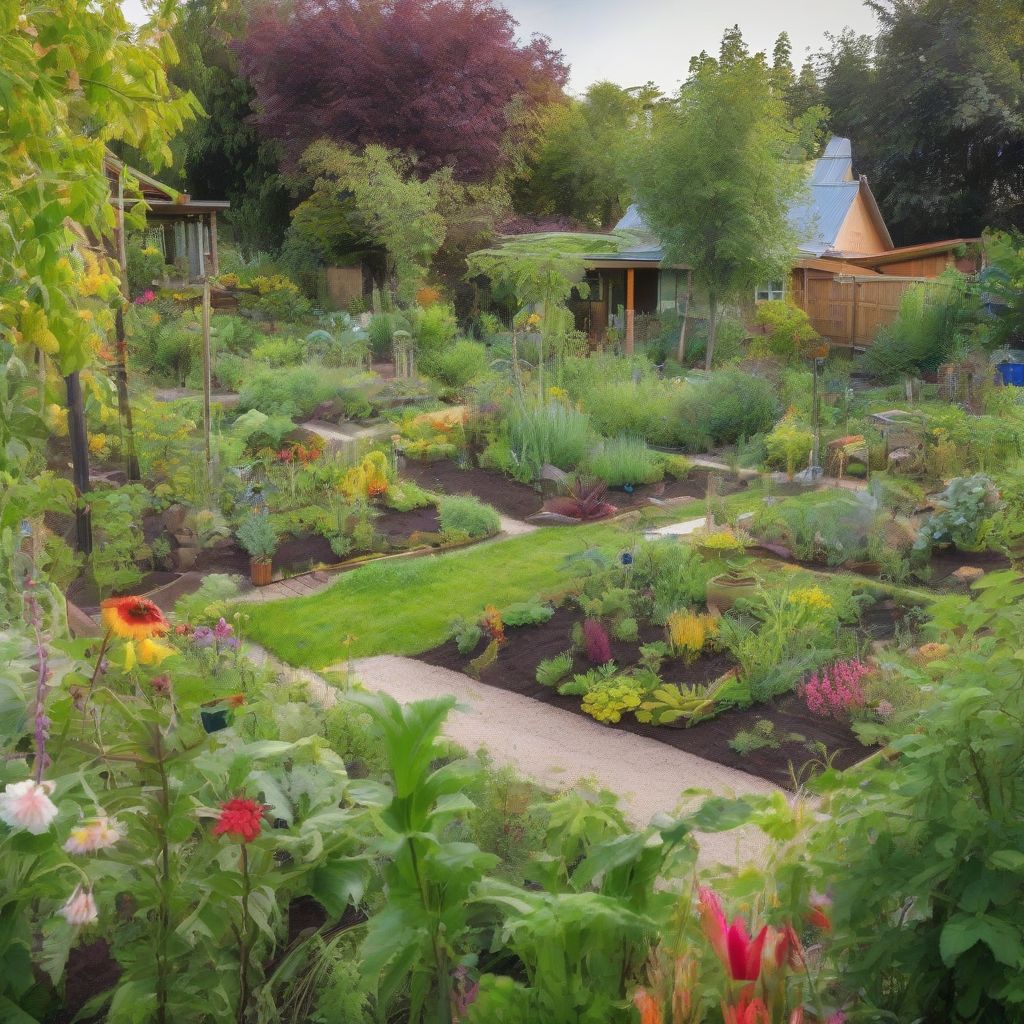Imagine stepping into a garden where lush fruits and vegetables grow in abundance, buzzing with life as pollinators dance from flower to flower. This isn’t a scene from a fairytale; it’s the potential of permaculture, a design system revolutionizing sustainable agriculture.
As a nutritionist and meal prep coach, I’ve always emphasized the importance of fresh, wholesome food for optimal health. But it goes beyond individual well-being; it’s about creating a food system that nourishes both people and the planet. This is where permaculture comes in, offering a holistic approach to food production that’s not only sustainable but also incredibly regenerative.
Understanding Permaculture: Beyond Organic Gardening
Permaculture, a portmanteau of “permanent agriculture” (and later “permanent culture”), is often perceived as simply a gardening technique, but it’s far more profound. It’s a design philosophy, a toolkit for problem-solving, and a way of life that seeks to create sustainable and self-sufficient systems by mimicking the patterns and relationships found in nature.
At its core, permaculture is about working with nature, not against it. It emphasizes observation, careful planning, and the integration of various elements to create a closed-loop system where waste is minimized, and resources are used efficiently.
The Principles of Permaculture in Action
Permaculture rests on a foundation of ethical principles – earth care, people care, and fair share – that guide its design and implementation. These principles are translated into practical strategies, including:
1. Observing and Interacting with Nature:
Before planting a single seed, permaculture practitioners observe the land, studying its contours, microclimates, water flow, and existing ecosystems. This understanding informs every design decision, ensuring it aligns with the natural environment.
2. Catching and Storing Energy:
Energy, whether it’s sunlight, water, or wind, is precious in permaculture. Techniques like rainwater harvesting, swales (shallow ditches that capture runoff), and solar energy systems are employed to capture and store energy, reducing reliance on external inputs.
3. Obtaining a Yield:
Permaculture gardens are designed for abundance. Diverse planting schemes, companion planting (strategically placing mutually beneficial plants together), and integrating food-producing trees create a multi-layered ecosystem that maximizes yield within a given space.
4. Applying Self-Regulation and Accepting Feedback:
Nature is constantly adapting and evolving. Permaculture systems are designed to be resilient, with natural pest control mechanisms, closed-loop nutrient cycling, and the ability to self-regulate. Regular observation and adjustments are essential to maintain balance.
5. Using and Valuing Renewable Resources and Services:
Permaculture prioritizes renewable resources. From building materials to energy sources, the focus is on utilizing what nature provides sustainably. This reduces dependence on finite resources and minimizes environmental impact.
6. Producing No Waste:
In permaculture, waste is viewed as a resource. Composting, vermiculture (using worms for composting), and other techniques transform organic waste into valuable fertilizer, enriching the soil and closing the loop.
7. Designing from Patterns to Details:
Observing patterns in nature provides valuable insights. Permaculture utilizes natural patterns like spirals, waves, and branching to design systems that optimize energy flow, maximize space utilization, and create a harmonious and aesthetic environment.
8. Integrating Rather than Segregating:
Permaculture thrives on diversity. By integrating different elements, such as combining animals, plants, and even human activities, synergistic relationships are created. For instance, chickens can control pests, while their manure fertilizes the soil.
The Impact of Permaculture on Sustainable Agriculture
Permaculture’s impact on sustainable agriculture is multifaceted and far-reaching:
1. Soil Health and Regeneration: Industrial agriculture often degrades soil health through monoculture (planting the same crop repeatedly), tilling, and chemical inputs. In contrast, permaculture practices, like no-till farming, cover cropping, and composting, enhance soil fertility, water retention, and biodiversity, effectively reversing degradation.
2. Water Conservation: As water scarcity becomes a pressing global issue, permaculture’s emphasis on water conservation is crucial. By mimicking natural water cycles, using drought-tolerant plants, and employing efficient irrigation techniques like drip irrigation, permaculture significantly reduces water usage in agriculture.
3. Biodiversity Preservation: Unlike monoculture, which reduces biodiversity and makes crops susceptible to pests and diseases, permaculture promotes polyculture (growing multiple crops together). This diverse planting approach enhances ecosystem resilience, attracts beneficial insects, and supports pollinator populations.
4. Reduced Carbon Footprint: Industrial agriculture is a significant contributor to greenhouse gas emissions. Permaculture sequesters carbon in the soil through practices like agroforestry (integrating trees into farming systems), reducing atmospheric carbon dioxide levels. Additionally, its emphasis on local food systems minimizes transportation, further lowering emissions.
5. Food Security and Sovereignty: Permaculture empowers communities to become more self-sufficient in food production. By creating resilient and productive local food systems, it enhances food security and reduces dependence on globalized food chains vulnerable to disruptions.
Embracing Permaculture: A Path to a Sustainable Future
The principles of permaculture offer a roadmap for creating a more sustainable and equitable food system. As we face the challenges of climate change, resource depletion, and food insecurity, embracing permaculture’s wisdom is not just an option; it’s a necessity.
Whether you’re a seasoned farmer or a city dweller with a balcony garden, incorporating permaculture principles can transform your approach to food production and consumption. By working in harmony with nature, we can cultivate abundance, regenerate our ecosystems, and create a future where both people and the planet thrive.
 Permaculture Garden
Permaculture Garden
Taking Action: Cultivating Your Own Permaculture Journey
Ready to embark on your own permaculture journey? Here are some starting points:
- Educate Yourself: Dive deeper into the principles and practices of permaculture through books, online resources, or workshops.
- Start Small: Begin with a small garden bed, a balcony container garden, or even just observing your local ecosystem.
- Connect with Others: Join local permaculture groups, attend workshops, or find a mentor to learn from experienced practitioners.
- Embrace the Process: Permaculture is a journey of continuous learning and adaptation. Embrace the process, be patient, and celebrate your successes along the way.
By taking these steps, you can contribute to a more sustainable and abundant future, one garden at a time.
What are your thoughts on permaculture? Have you incorporated any of its principles into your life? Share your experiences and questions in the comments below!
[amazon bestseller=”permaculture”]
